Archive for the ‘Medicinal Plants’ Category
Wednesday, December 18, 2013

Detail of hazel tree in The Unicorn is Killed and Brought to the Castle (from the Unicorn Tapestries), 1495–1505. The Metropolitan Museum of Art, New York, Gift of John D. Rockefeller Jr., 1937 (37.80.5)
The common hazel, or Corylus avellana, is an understory tree native to Europe and western Asia and is widely distributed from Scandinavia to the Mediterranean. The English name for the tree is derived from the Anglos-Saxon word haesel. The hazel appears in two critical medieval horticultural sources, the Carolingian Capitulare de Villis and in the St. Gall Plan, along with references in folklore, literature, and both Pagan and Christian traditions. The hazel is still cultivated today for its nuts, which are harvested after they have fallen from the tree in autumn. Hazelnuts are commercially grown in Oregon and Washington, although Turkey exports 75% of the world’s supply. Read more »
Tags: hazel, Unicorn tapestries
Posted in Food and Beverage Plants, Magical Plants, Medicinal Plants, Plants in Medieval Art | Comments (1)
Friday, June 7, 2013
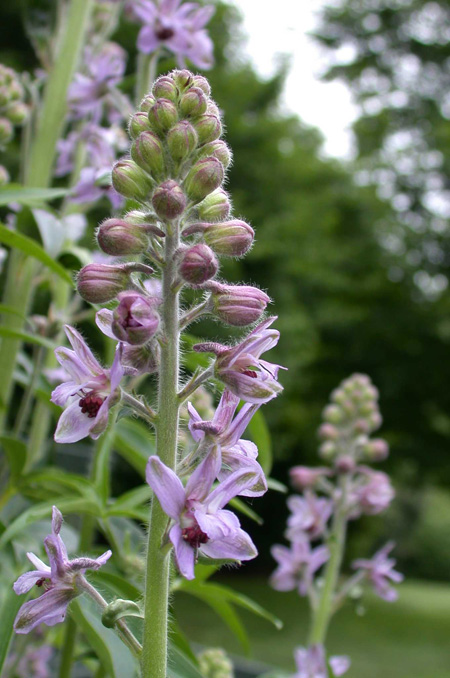
A beautiful plant related to the ornamental delphiniums and larkspurs of our gardens, stavesacre is a poisonous member of the buttercup family. Its seeds were used topically to kill scabies and lice in antiquity and in the Middle Ages. Since this Mediterranean native isn’t winter hardy in our climate, seeds must be started indoors or in a cold frame; the young plants are set out once the danger of frost is past.
Read more »
Tags: buttercup, delphinium, Dioscorides, Ranunculaceae, stavesacre
Posted in Gardening at The Cloisters, Medicinal Plants | Comments (7)
Friday, May 24, 2013
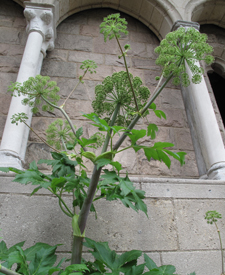
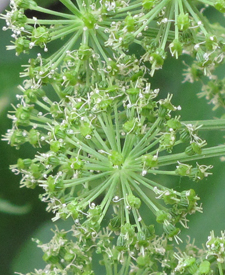
Left: Angelica silhouetted against the blind arcade in Bonnefont cloister. Modern gardeners admire the bold, architectural qualities of angelica as an ornamental plant, but it has a long history as a useful herb. Right: The flower structure is typical of the carrot family to which it belongs. Photographs by Carly Still
Unknown to the Greeks and Romans, the beautifully named Angelica archangelica is a native of northern Europe. It can be difficult to determine whether it is this “garden angelica” or its close relative, A. sylvestris, that is under discussion in early sources, although Renaissance plantsmen like John Gerard distinguished between the two (see images of A. sylvestris in the wild).
Read more »
Tags: angelica, Angelica archangelica, Angelica sylvestris, asafoetida, carrot, parsley
Posted in Food and Beverage Plants, Gardening at The Cloisters, Medicinal Plants | Comments (0)
Friday, May 3, 2013
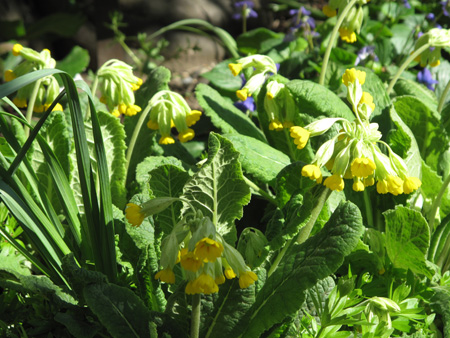
This pretty yellow flower, gathered since the Middle Ages when “bringing in the May,” was known in Middle English by various names, including primerose, primerole, and cowslyppe. Photograph by Carly Still
Primula veris, literally the “first little one of spring,” was known in Middle English as prymerole and as prymerose, or “the first rose.” It was also known as cowslip, a name thought to be derived from “cow slop” or dung, perhaps because it grew in meadows and pastures where cattle grazed. The names prymerole and prymerose came from the Latin through Old French, and were shared with the cowslip’s relative, the common primrose (Primula vulgaris). As Geoffrey Grigson notes in his fascinating compendium of plant lore, The Englishman’s Flora, it can be very difficult to distinguish which of the two species is meant in early sources. Renaissance plantsmen like William Turner, John Gerard, and John Parkinson tried to clarify the confusion caused by the shared common names; as late as the eighteenth century, the great Swedish naturalist and taxonomist Carolus Linnaeus considered the cowslip, the common primrose, and the oxlip (Primula elatior; see image) to be forms of the same species.
Read more »
Tags: cowslip, cuckoo, primrose, Primula veris
Posted in Medicinal Plants, Plants in Medieval Art, The Medieval Calendar | Comments (0)
Friday, April 26, 2013
Cowslips of Jerusalem, or the true and right Lungwoorte, hath rough, hairie, & large leaves, of a browne greene colour, confusedly spotted with divers spots or droppes of white: amongst which spring up certain stalks, a span long, bearing at the top many fine flowers, growing together like the flowers of cowslips, saving that they be at the first red or purple, and sometimes blewe, and oftentimes of all these colours at once.
???John Gerard, The Herball, or General Historie of Plants, 1597
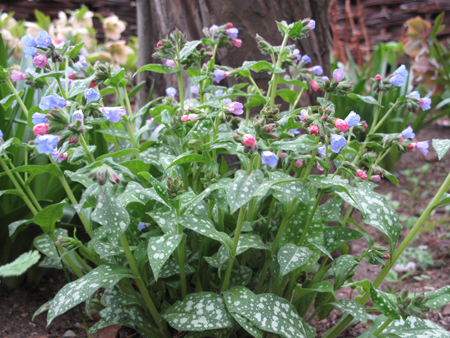
The common lungwort or pulmonaria, growing under one of the veteran quince trees in Bonnefont garden. Native to central Europe, but widely naturalized, the early blooming lungwort is a denizen of damp, deciduous woodlands and hedgerows. The characteristic silvery-white spots scattered on its leaves were a sign of its medicinal value in treating lung complaints. Lungwort was already a common garden plant by the sixteenth century and many ornamental cultivated forms are now grown. Photograph by Carly Still
Read more »
Tags: borage, Boraginaceae, hellebore, lung, lungworts, pulmonaria, quince
Posted in Gardening at The Cloisters, Medicinal Plants | Comments (2)
Friday, April 5, 2013
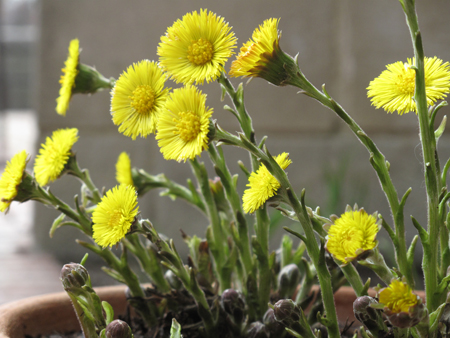
Coltsfoot blooming in a pot in Bonnefont garden. The scaly stems and bright yellow blossoms of this early-spring-blooming member of the daisy family emerge well before the foliage; the hoof-shaped leaves appear only after the flowers have set seed. This notoriously invasive Eurasian species is best grown in a container. Photograph by Carly Still
Tussilago farfara, known in the Middle Ages under the Latin names ungula caballina (”horse hoof”) and pes pulli (”foal’s foot”), is still called coltsfoot, ass’s foot, or bull’s foot in English, pas-de-poulain in French, pie d’asino in Italian, and hufflatich in German. These names all derive from the fancied resemblance of the young leaf to the foot of a quadruped. See an image of the plant in leaf. A slideshow of images of Tussilago farfara in all stages of growth is available at Arkive.org.
Read more »
Tags: Asteraceae, coltsfoot, Dioscorides, Hildegard of Bingen, Hortus Sanitatis, Pliny, tussilago
Posted in Gardening at The Cloisters, Medicinal Plants | Comments (4)
Thursday, October 4, 2012
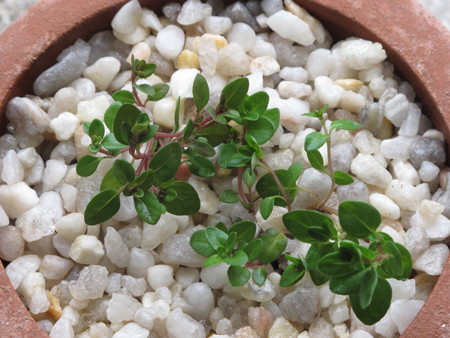
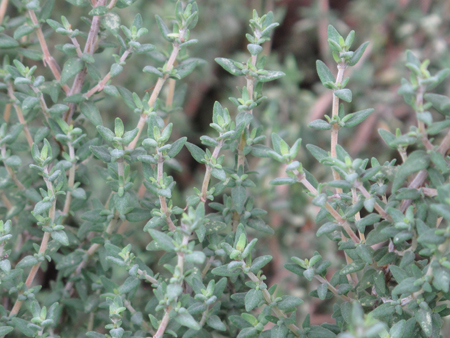
From right to left: A small start of wild or creeping thyme, a native of Northern Europe, in a terra rossa pot; detail of a planting of common or garden thyme, indigenous to the Western Mediterranean, growing in a sunny bed under the parapet wall in Bonnefont cloister. Although these two plants are easily distinguished in the garden, it can be difficult to know which of several species of thyme is under discussion in ancient and medieval sources.
There are hundreds of?? species in the genus Thymus, and a large and confusing array of hybrids and cultivated forms.??Ancient and medieval sources agree on the heating and drying properties of thyme, which is still greatly valued for its antibacterial and antifungal properties, but the species known in the European Middle Ages were not those of the ancients. The attempt to equate the plants discussed by Dioscorides in the De Materia Medica with more familiar species would occupy botanists well into the Renaissance.
Read more »
Tags: Dioscorides, Hildegard of Bingen, Pliny, thyme
Posted in Botany for Gardeners, Food and Beverage Plants, Fragrant Plants, Gardening at The Cloisters, Medicinal Plants | Comments (1)
Friday, September 21, 2012
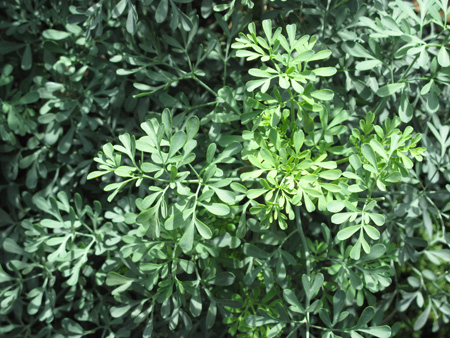
The blue-green fronds of rue were admired for their beauty in the Middle Ages, and the intensely aromatic leaves were prized as a condiment, a medicament, and an amulet.?? Photograph by Carly Still
Here is a shadowed grove which takes its color
From the miniature forest of glaucous rue.
Through its small leaves and short umbels which rise
Like clusters of spears it sends the wind???s breath
And the sun’s rays down to its roots below.
Touch it but gently and it yields a heavy
Fragrance. Many a healing power it has ???
Especially, they say, to combat
Hidden toxin and to expel from the bowels
The invading forces of noxious poison.
???Hortulus, Walahfrid Strabo, translated by Raef Payne
Read more »
Tags: Anethum graveolens, Apicius, Apium graveolens, bitter, Capitulare de Villis, Dioscorides, Hildegard of Bingen, Hortulus, Mithridates VI, mithridatum, phytodermatitis, Pliny, rue, Ruta graveolens, St. Gall, Tacuinum Sanitatis, Walahfrid Strabo
Posted in Food and Beverage Plants, Fragrant Plants, Gardening at The Cloisters, Magical Plants, Medicinal Plants | Comments (0)
Friday, September 14, 2012
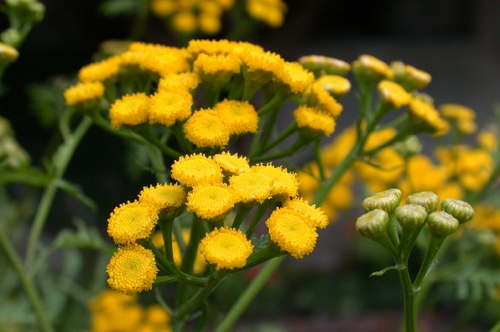
Unlike many of its relatives in the Asteraceae, or daisy family,??the golden disk flower of tansy is not surrounded by ray petals.??Although both the flowers and leaves are intensely bitter, tansy has a long history as a culinary herb.??
Tansy (reynfan) is hot and a bit moist, and is effective against all over-abundant humors which flow out. Whosoever has catarrh, and coughs because of it, should eat tansy, taken either in broth or small tarts, or with meat, or any other way. It checks the increase of the humors, and they vanish . . . .
???Hildegard of Bingen,??Physica,??Chapter CXI
The old German name reynfan used by Hildegard refers to the effect of tansy (Tanacetum vulgare) on the “reins,” or kidneys. The fifteenth-century herbal??Der Gart der Gesundheit differs from Hildegard in classifying tansy as hot and dry in the first degree, rather than moist; it recommends tansy as a diuretic and vermifuge, as well as a treatment for gout and fever. (For more on Hildegard of Bingen, see “Mutter Natur,” October 15, 2010. For more on the humoral theory on which her prescription is based, see “Cool, Cooler, Coolest,” July 27, 2012.) Read more »
Tags: Bonnefont Garden, daisy, Hildegard of Bingen, John Gerard, reynfan, Tanacetum, tansy, Walahfrid Strabo
Posted in Food and Beverage Plants, Gardening at The Cloisters, Medicinal Plants, The Medieval Garden | Comments (0)
Friday, September 7, 2012
Crithmon, some call it Critamon, is a little shrubbie herbe, thick of leaves, the height of it is about a cubit, growing in rockie and maritime places, being full of fatt, and whitish leaves, like unto those of Purcelane, yet thicker & longer & salt to ye tast.
???Dioscorides, De Materia Medica, Book II: 157
Rock samphire is one of several maritime species grown in Bonnefont herb garden. This edible plant was foraged rather than cultivated in the Middle Ages; it also had medicinal uses. Below, left to right: Samphire in bloom; the flower structure is typical of the Apiaceae, a large family of??aromatic plants. Ripening seedheads; the name “crithmon” by which the plant was known in antiquity is thought to derive from the Greek word for barley, as the seeds resemble the grain.
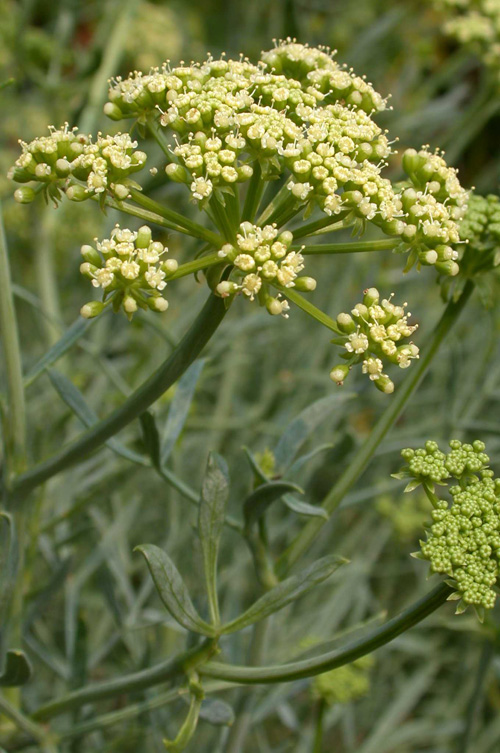
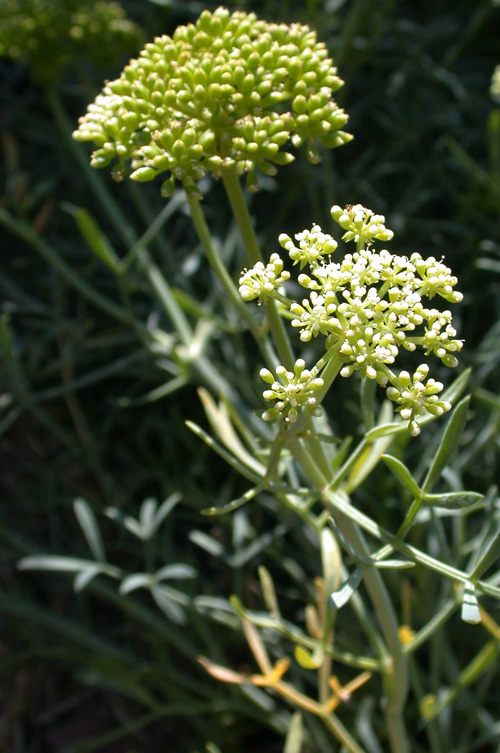
Read more »
Tags: Apiaceae, Crithmum maritimum, Dioscorides, glasswort, John Gerard, King Lear, Pliny the Elder, rock samphire, Salicornia europea, sampier
Posted in Gardening at The Cloisters, Medicinal Plants, Useful Plants | Comments (0)













